Forming Process Prediction Model and Application of Laser Cladding for Remanufactured Screw Pump Rotors
Abstract
:1. Introduction
2. Materials and Methods
2.1. Experimental Equipment and Materials
2.2. Experimental Design and Results
2.2.1. Single-Pass Laser Cladding Experiment
2.2.2. Multi-Pass Laser Cladding Experiment
3. Results and Analysis
3.1. Geometrical Characterization of Cladding Layer
3.1.1. Prediction Model for Cladding Layer Geometry
3.1.2. Influence of Process Parameters on Cladding Layer Geometry
3.2. Cladding Layer Quality
3.2.1. Cladding Layer Quality Prediction Model
3.2.2. Influence of Process Parameters on Cladding Layer Quality
4. Validation of Cladding Process Prediction Model
4.1. Experimental Verification of Single-Pass Laser Cladding
4.2. Experimental Verification of Multi-Pass Laser Cladding
4.3. Experimental Verification of Laser Cladding for 3D Repair
4.4. Optimization of Microstructure and Performance Testing of Clad Specimens
4.4.1. Microstructure of Optimized Cladding Specimen
4.4.2. Analysis of Coating Friction and Wear
5. Conclusions
Author Contributions
Funding
Institutional Review Board Statement
Informed Consent Statement
Data Availability Statement
Acknowledgments
Conflicts of Interest
Abbreviations
| ANOVA | Analysis of variance |
| RSM | Response Surface Methodology |
| CCD | Central Composite Design |
| GRA | Gray Relationship Analysis |
| LAAM | Laser-assisted additive manufacturing |
| WOA-Bi-LSTM | Whale Optimization Algorithm–Bi-Directional Long Short-Term Memory |
| P | Laser power |
| vf | Powder feeding rate |
| vs | Scanning speed |
| h | Height of cladding |
| w | Width of cladding |
| d | Center distance |
| hs | Height difference |
| D | Depth of cladding |
| η | Dilution rate |
References
- Wang, M.L.; Li, Q.; Huang, Z.Q.; Qian, W.J.; Chen, X.; Li, Q.; Lai, T.H. Influence of surface texture parameters of screw pump rotor on tribological properties of its friction pairs. Ind. Lubr. Tribol. 2022, 74, 964–974. [Google Scholar] [CrossRef]
- Borisova, K.E.; Ivanova, T.N.; Latypov, R.G. Study of Screw Pump Stator and Rotor Working Capacity to Increase the Output. Procedia Eng. 2017, 206, 688–691. [Google Scholar] [CrossRef]
- Yao, L.M.; Xiao, Z.M.; Hoo, Z.S.; Tang, C.; Qiao, J.; Zhang, Y.M. Mechanism analysis of grain growth dominated by alloy composition gradients during powder bed fusion. Mater. Res. Lett. 2023, 11, 814–820. [Google Scholar] [CrossRef]
- Liu, J.D.; Ba, Z.Y.; Shu, D. Laser Cladding Path Planning for Curved Metal Parts. Metals 2024, 14, 1055. [Google Scholar] [CrossRef]
- Huang, H.L.; Zhou, L.; Luo, S.M. Laser cladding path planning for gear repair based on area division and trajectory correction. Int. J. Adv. Manuf. Technol. 2024, 134, 3719–3732. [Google Scholar] [CrossRef]
- Zu, H.Y.; Lu, X.Y.; Song, Y.J.; Li, D.Q. Robot simulation of PDC bit remanufacturing based on laser cladding. Trans. China Weld. Inst. 2022, 43, 71–76. [Google Scholar] [CrossRef]
- Wu, Y.; Ma, P.Z.; Bai, W.Q.; Chen, W.Q. Numerical Simulation of Temperature Field and Stress Field in 316L/AISI304 Laser Cladding with Different Scanning Strategies. Chin. J. Lasers 2021, 48, 18–29. [Google Scholar] [CrossRef]
- Yang, X.; Li, Z.; Cao, L.; Chen, L.; Huang, Q.; Bi, G. Process optimization and quality prediction of laser aided additive manufacturing SS 420 based on RSM and WOA-Bi-LSTM. Mater. Today Commun. 2024, 38, 107882. [Google Scholar] [CrossRef]
- Zhang, W.H.; Cai, Z.H.; Chen, T.Y.; Wang, X.Y.; Qu, D.B.; Ma, Z.H. A Path Planning Method for Polishing Thermal Barrier Coatings on the Surface of Aero-Engine Blades Based on Point Cloud Slicing. J. Therm. Spray Technol. 2024, 33, 33–50. [Google Scholar] [CrossRef]
- Gao, S.; Fu, Q.; Li, M.; Huang, L.; Liu, N.; Cui, C.; Zhang, G. Optimization of Laser Cladding Parameters for High-Entropy Alloy-Reinforced 316L Stainless-Steel via Grey Relational Analysis. Coatings 2024, 14, 1103. [Google Scholar] [CrossRef]
- Kermani, F.; Razavi, R.S.; Zangenemadar, K.; Borhani, M.; Gavahian, M. Optimization of single-pass geometric characteristics of IN718 by fiber laser via linear regression and response surface methodology. J. Mater. Res. Technol. 2023, 24, 274–289. [Google Scholar] [CrossRef]
- Wang, P.F.; Yang, K.; Chen, M.Z.; Wang, Z.D.; Lu, Y.; Sun, G.F.; Ni, Z.H. Simulation and Experimental Research on the GH3536 Molten Pool Laser Cladding on Inclined Substrate. Chin. J. Lasers 2021, 48, 210–221. [Google Scholar] [CrossRef]
- Kaya, G.; Yildiz, F.; Korkmaz, I.H.; Kaymaz, I.; Yetim, A.F.; Ergueder, T.O.; Sen, C. Effects of process parameters on selective laser melting of Ti6Al4V-ELI alloy and parameter optimization via response surface method. Mater. Sci. Eng. A 2023, 885, 145581. [Google Scholar] [CrossRef]
- Long, H.; Li, T.; Shi, H.; Gui, Y.; Qiu, C. Experimental Study of Laser Cladding Ni-Based Coating Based on Response Surface Method. Coatings 2023, 13, 1216. [Google Scholar] [CrossRef]
- Chen, B.; Zhao, Y.; Yang, H.; Zhao, J. Process Parameters Optimization and Numerical Simulation of AlCoCrFeNi High-Entropy Alloy Coating via Laser Cladding. Materials 2024, 17, 4243. [Google Scholar] [CrossRef]
- Shu, L.; Shi, J.; Huang, T.; Li, P.; Wu, H.; Zhou, J. Optimization of laser cladding powder ratio and process parameters based on MOGWO algorithm. Mater. Today Commun. 2024, 41, 110605. [Google Scholar] [CrossRef]
- Wang, W.C.; Li, J.X.; Yuan, G.E.; Kong, D.J. Structural characteristics and high–temperature tribological behaviors of laser cladded NiCoCrAlY–B4C composite coatings on Ti6Al4V alloy. Trans. Nonferrous Met. Soc. China 2021, 31, 2729–2739. [Google Scholar] [CrossRef]
- Nandi, S.K.; Ajithkannan, R.; Withers, P.J.; Matthews, A.; Roy, S.; Manna, I. Effect of laser process parameters on the dilution, microstructure, and wear behaviour of Tribaloy™ T800 cladding on AISI 316 stainless steel. J. Mater. Sci. 2024, 59, 9042–9058. [Google Scholar] [CrossRef]
- Amar, E.; Popov, V.; Sharma, V.M.; Batat, S.A.; Halperin, D.; Eliaz, N. Response surface methodology (RSM) approach for optimizing the processing parameters of 316L SS in directed energy deposition. Materials 2023, 16, 7253. [Google Scholar] [CrossRef]
- Fu, J.; Yang, Q.; Devojno, O.; Kardapolava, M.; Kasiakova, I.; Wang, C. Wear Resistance Design of Laser Cladding Ni-Based Self-Fluxing Alloy Coating Using Machine Learning. Materials 2024, 17, 5651. [Google Scholar] [CrossRef]
- Xi, W.; Song, B.; Zhao, Y.; Yu, T.; Wang, J. Geometry and dilution rate analysis and prediction of laser cladding. Int. J. Adv. Manuf. Technol. 2019, 103, 4695–4702. [Google Scholar] [CrossRef]
- Qian, S.; Dai, Y.; Guo, Y.; Zhang, Y. Microstructure and wear resistance of multi-layer Ni-based alloy cladding coating on 316L SS under different laser power. Materials 2021, 14, 781. [Google Scholar] [CrossRef] [PubMed]
- Li, T.; Bi, Z.; Lei, Y. Effects of Scanning Speed on the Microstructure and Wear Properties of Rockit 606 Coating Layer by Disk Laser Cladding. Materials 2024, 17, 4758. [Google Scholar] [CrossRef] [PubMed]
- Jiang, R.; Lin, C.; Li, Y.; Tang, C.; Chen, X. Optimization of Laser Cladding Process Parameters and Analysis of Organizational Properties of Mixer Liners. Materials 2024, 17, 5158. [Google Scholar] [CrossRef]
- Li, J.; Yang, Y.; Chen, L.; Yu, T.; Zhao, J.; Wang, Z. Multi-Objective Optimization of Process Parameters in Laser DED Ni-Based Powder on Steel Rail Using Response Surface Design. Coatings 2024, 14, 401. [Google Scholar] [CrossRef]
- Yao, L.; Huang, S.; Ramamurty, U.; Xiao, Z. On the formation of “Fish-scale” morphology with curved grain interfacial microstructures during selective laser melting of dissimilar alloys. Acta Mater. 2021, 220, 117331. [Google Scholar] [CrossRef]
- Yao, L.; Xiao, Z.; Huang, S.; Ramamurty, U. The formation mechanism of metal-ceramic interlayer interface during laser powder bed fusion. Virtual Phys. Prototyp. 2023, 18, e2235324. [Google Scholar] [CrossRef]
- Su, J.; Li, A.; Ruan, Y.; Qiu, X.; Liang, J. Repair of tungsten heavy alloy die casting molds with laser cladded CoCrFeNiWx high entropy alloy Coatings: Microstructure, wear properties and tempering stability. Eng. Fail. Anal. 2024, 161, 108291. [Google Scholar] [CrossRef]
- Shi, X.S.; Jiang, F.L.; Wang, Y.L.; Yang, F.Z.; Yang, Y.; Liang, P.; Ma, B.S. Morphology and Quality Prediction of Laser Cladding 3540Fe Coating Based on Response Surface Method. Surf. Technol. 2022, 51, 392–405. [Google Scholar]
- Lian, G.; Liu, Z.; Zhang, Y.; Feng, M.; Chen, C.; Jiang, J. The forming control method of multi-track laser cladding on curved surface. Metals 2020, 10, 1109. [Google Scholar] [CrossRef]
- Yao, X.Y.; Lin, Q.; Ding, H.H.; Wang, W.J.; Guo, J.; Zhu, Y.; Gan, L. Optimization of Process Parameters of Ni60+WC Laser Cladding Coating Based on Taguchi–Grey Relation Method. Surf. Technol. 2023, 52, 394–405. [Google Scholar] [CrossRef]
- Liu, J.; Sun, W.; Huang, Y. An algorithm for trajectory planning of complex surface parts for laser cladding remanufacturing. Proc. Inst. Mech. Eng. Part B J. Eng. Manuf. 2021, 235, 2025–2032. [Google Scholar] [CrossRef]
- Ma, W.; Hu, T.; Zhang, C.; Zhang, T. A robot motion position and posture control method for freeform surface laser treatment based on NURBS interpolation. Robot. Comput. Integr. Manuf. 2023, 83, 102547. [Google Scholar] [CrossRef]
- Li, Y.; Chen, T.; Liu, D. Path planning for laser cladding robot on artificial joint surface based on topology reconstruction. Algorithms 2020, 13, 93. [Google Scholar] [CrossRef]
- Li, L.; Cui, Q.; Zhou, J.; Lu, Z.; Sun, H.; Jiang, H.; Guo, W.; Wu, A. Study on the Influence of Laser Power on the Heat–Flow Multi-Field Coupling of Laser Cladding Incoloy 926 on Stainless Steel Surface. Materials 2024, 17, 4769. [Google Scholar] [CrossRef] [PubMed]
- He, J.; Cai, Z.; Ren, Y.; Peng, J.; Liu, J.; Zhu, M. Optimization of several surface treatment processes for alleviating fretting damage of a locking pin. Friction 2022, 10, 1217–1233. [Google Scholar] [CrossRef]
- Weng, Z.; Gu, K.; Cui, C.; Cai, H.; Liu, X.; Wang, J. Microstructure evolution and wear behavior of titanium alloy under cryogenic dry sliding wear condition. Mater. Charact. 2020, 165, 110385. [Google Scholar] [CrossRef]

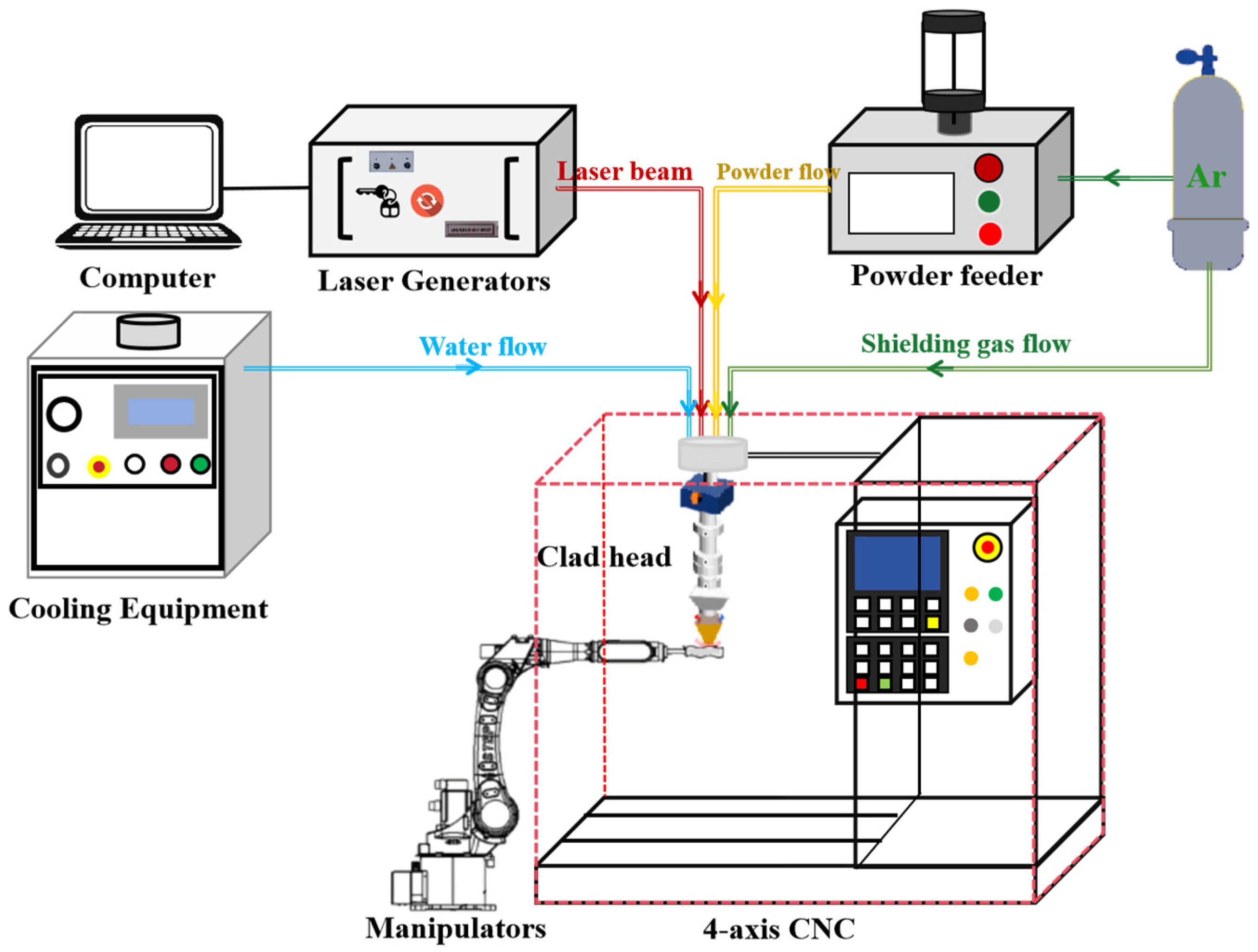


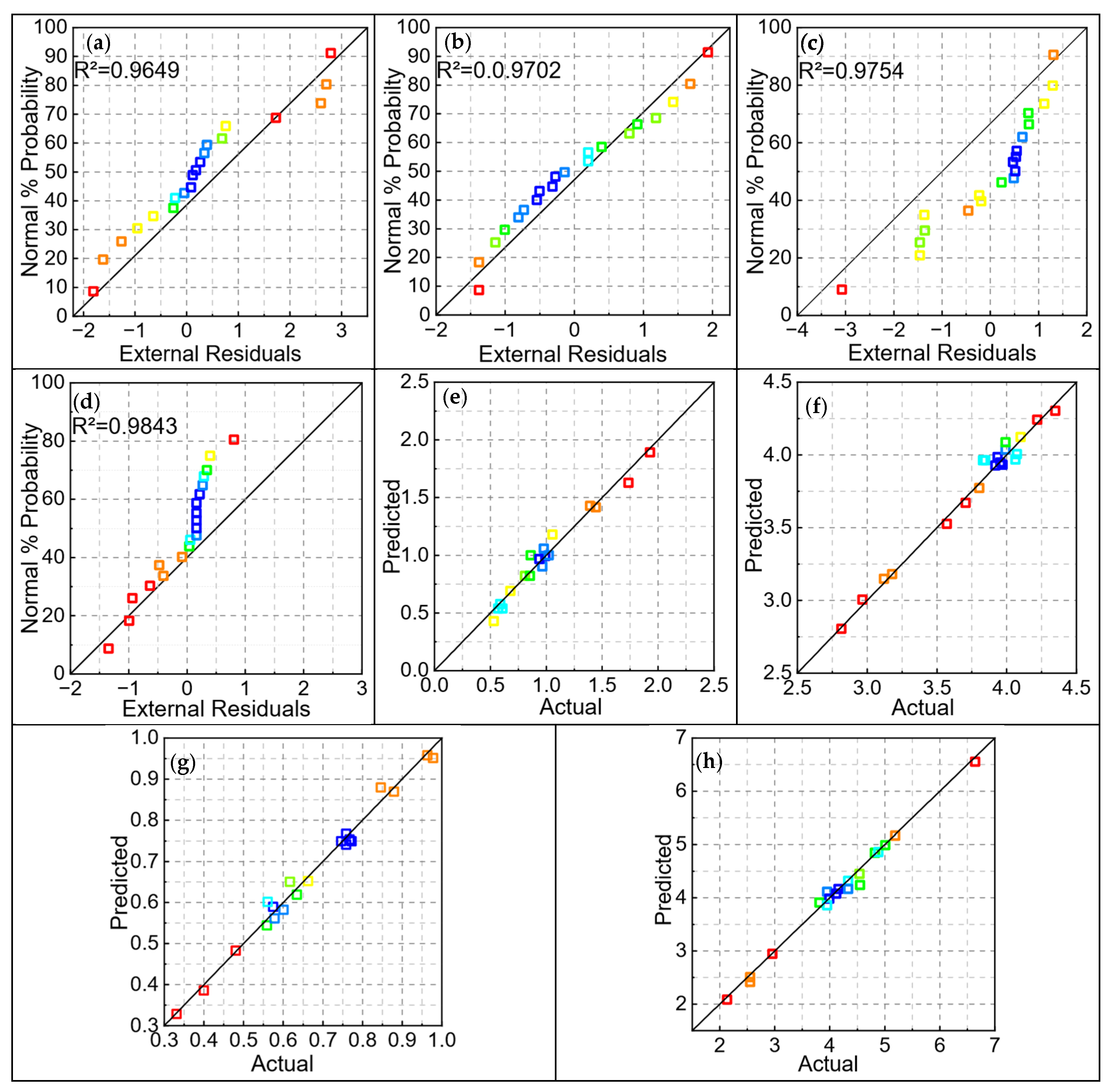

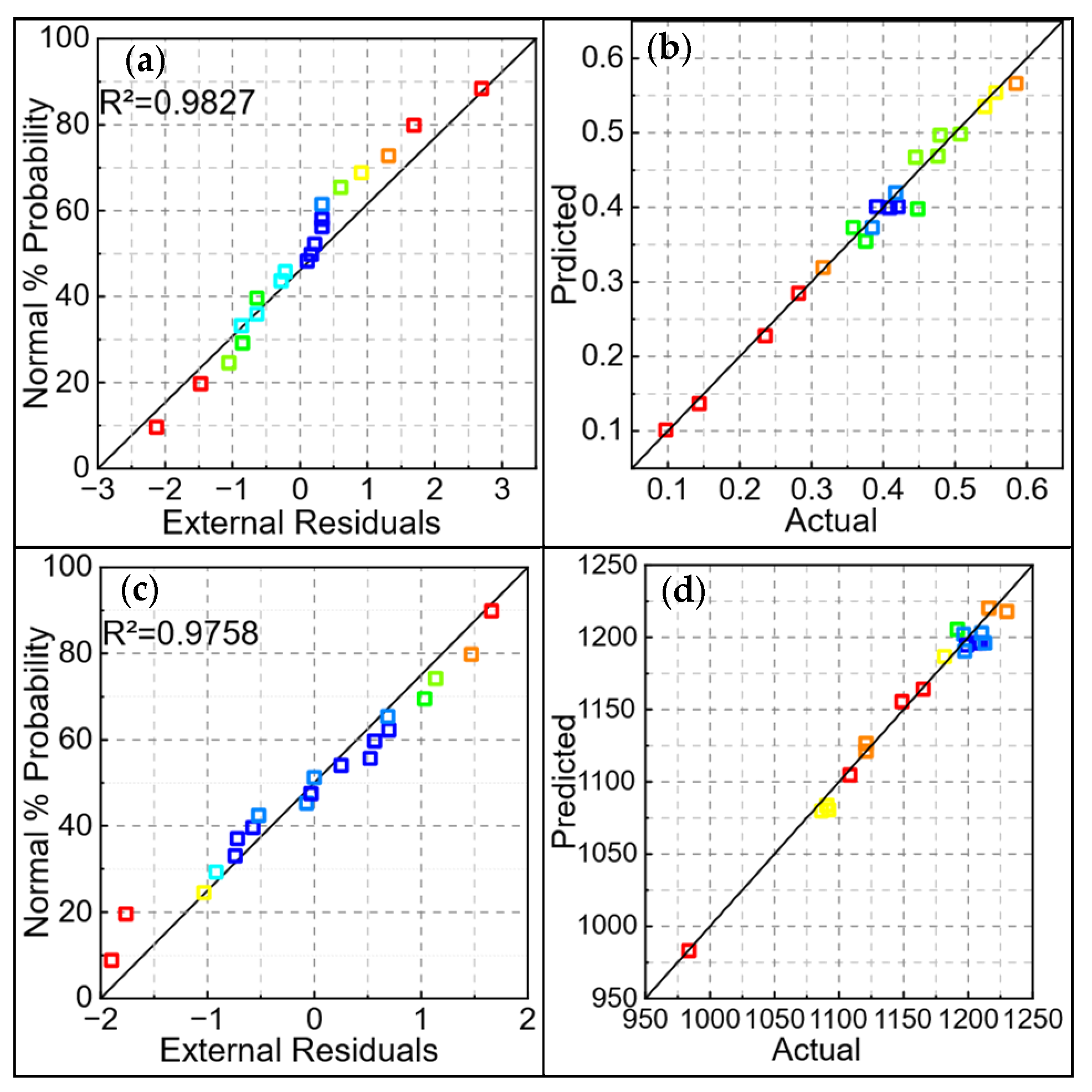
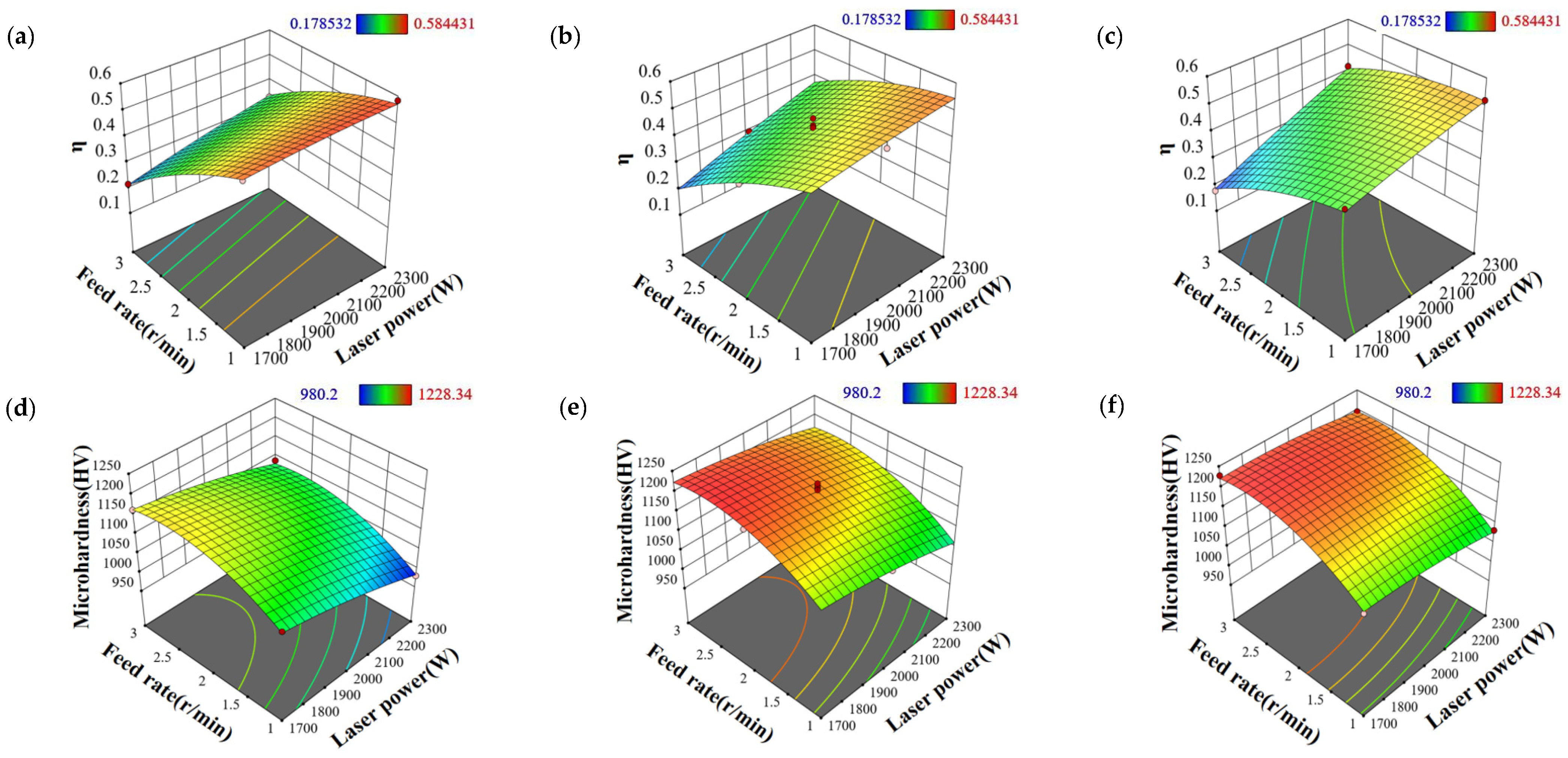


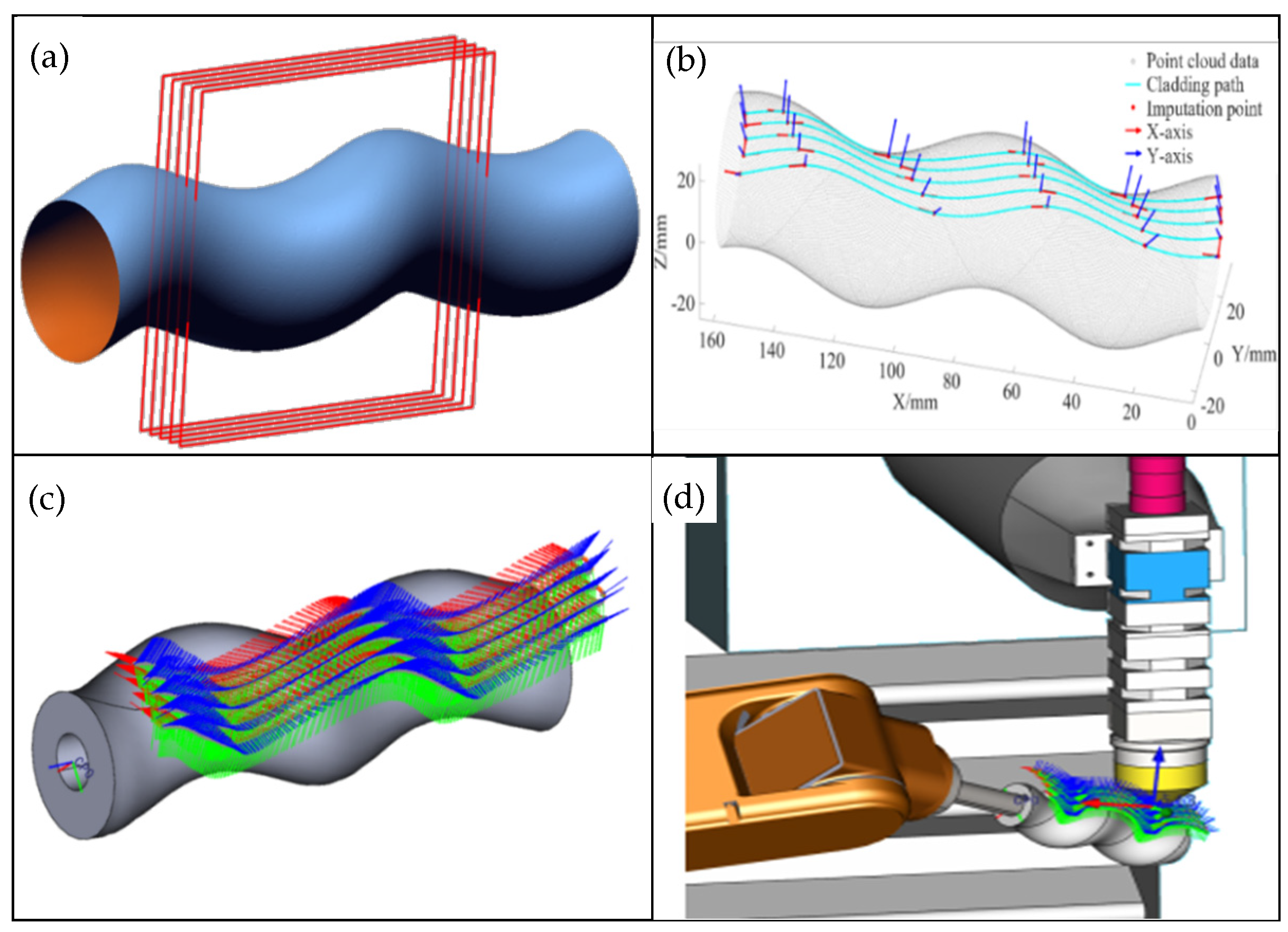
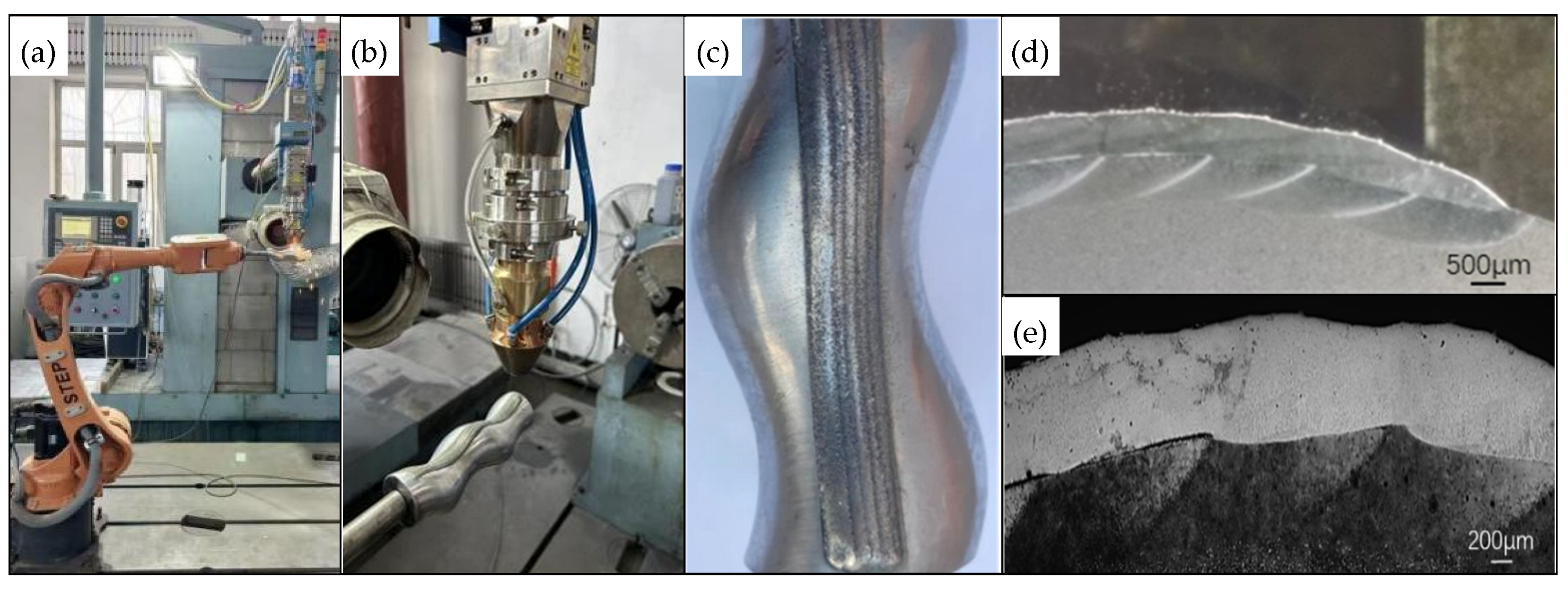
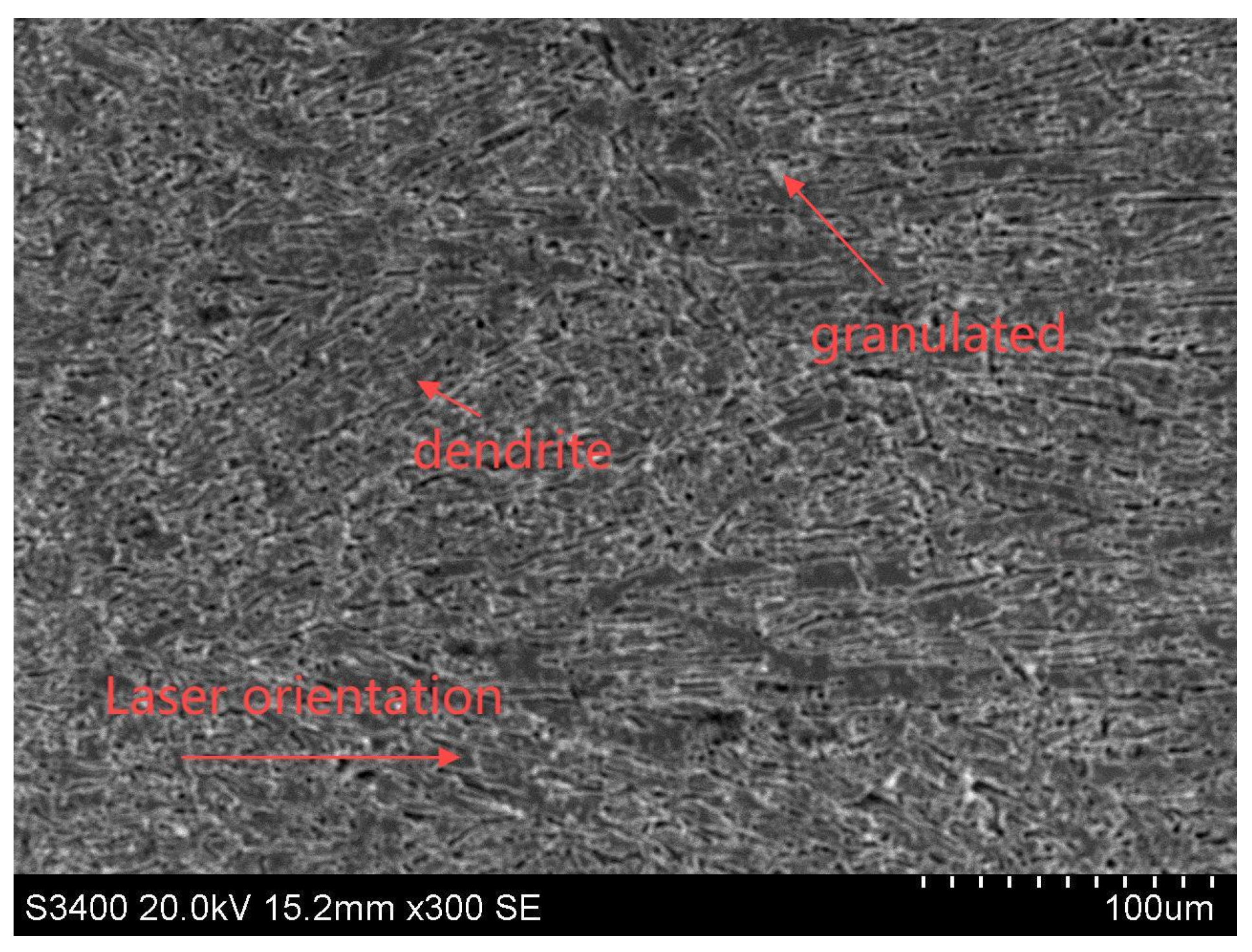

| wt.% | ||||
|---|---|---|---|---|
| C | Ni | Mn | Cr | Fe |
| 0.42–0.5 | ≤0.25 | 0.5–0.8 | ≤0.25 | Bal. |
| wt.% | ||||||
|---|---|---|---|---|---|---|
| C | S | Mn | Cr | Si | B | Fe |
| 0.35 | 0.03 | 0.29 | 0.12 | 0.1 | 0.18 | Bal. |
| Level | P (W) | vf (r/min) | vs (mm/min) |
|---|---|---|---|
| −1 | 1700 | 1 | 400 |
| 0 | 2000 | 2 | 600 |
| 1 | 2300 | 3 | 800 |
| Number | Factor | Response Value | |||||||
|---|---|---|---|---|---|---|---|---|---|
| P (W) | vf (r/min) | vs (mm/min) | h (mm) | w (mm) | D (mm) | w/h | η (%) | Microhardness (HV) | |
| 1 | 1700 | 1 | 400 | 0.543 | 3.585 | 0.66 | 6.604 | 54.945 | 1089.20 |
| 2 | 2300 | 1 | 400 | 0.694 | 3.123 | 0.98 | 4.500 | 58.443 | 980.20 |
| 3 | 1700 | 3 | 400 | 2.014 | 4.242 | 0.56 | 2.106 | 21.726 | 1162.72 |
| 4 | 2300 | 3 | 400 | 1.745 | 4.362 | 0.87 | 2.499 | 33.346 | 1088.99 |
| 5 | 1700 | 1 | 800 | 0.591 | 2.954 | 0.41 | 5.001 | 40.912 | 1119.18 |
| 6 | 2300 | 1 | 800 | 0.579 | 2.815 | 0.63 | 4.864 | 52.100 | 1083.93 |
| 7 | 1700 | 3 | 800 | 1.500 | 3.799 | 0.33 | 2.533 | 17.853 | 1028.34 |
| 8 | 2300 | 3 | 800 | 0.821 | 3.923 | 0.59 | 4.776 | 41.885 | 1196.34 |
| 9 | 1700 | 2 | 600 | 0.992 | 3.985 | 0.57 | 4.018 | 36.413 | 1213.37 |
| 10 | 2300 | 2 | 600 | 0.950 | 3.988 | 0.85 | 4.200 | 47.200 | 1145.45 |
| 11 | 2000 | 1 | 600 | 0.619 | 3.186 | 0.60 | 5.146 | 49.257 | 1107.60 |
| 12 | 2000 | 3 | 600 | 1.369 | 4.105 | 0.58 | 2.999 | 29.614 | 1189.50 |
| 13 | 2000 | 2 | 400 | 1.053 | 4.011 | 0.85 | 3.808 | 44.601 | 1118.24 |
| 14 | 2000 | 2 | 800 | 0.858 | 3.731 | 0.57 | 4.348 | 39.954 | 1196.92 |
| 15 | 2000 | 2 | 600 | 1.040 | 4.108 | 0.75 | 3.950 | 41.933 | 1205.30 |
| 16 | 2000 | 2 | 600 | 1.001 | 4.123 | 0.78 | 4.120 | 43.740 | 1174.50 |
| 17 | 2000 | 2 | 600 | 0.981 | 3.877 | 0.77 | 3.950 | 43.995 | 1203.20 |
| 18 | 2000 | 2 | 600 | 0.949 | 3.908 | 0.76 | 4.120 | 44.451 | 1209.59 |
| 19 | 2000 | 2 | 600 | 0.864 | 3.928 | 0.77 | 4.545 | 47.100 | 1199.80 |
| 20 | 2000 | 2 | 600 | 0.985 | 3.831 | 0.76 | 3.889 | 43.682 | 1215.60 |
Source | Height of Cladding Layer | Width of Cladding Layer | |||||||||
|---|---|---|---|---|---|---|---|---|---|---|---|
| Sum of Squares | df | Mean Square | F-Value | P-Value | Sum of Squares | df | Mean Square | F-Value | P-Value | ||
| Model | 2.74 | 6 | 0.4570 | 59.55 | <0.0001 | 3.43 | 9 | 0.3807 | 36.23 | <0.0001 | |
| Laser power | 0.0724 | 1 | 0.0724 | 9.43 | 0.0890 | 0.0125 | 1 | 0.0125 | 1.19 | 0.3004 | |
| Powder feed rate | 1.96 | 1 | 1.9600 | 255.02 | <0.0001 | 2.2700 | 1 | 2.2700 | 216.37 | <0.0001 | |
| Scanning speed | 0.2891 | 1 | 0.2891 | 37.66 | <0.0001 | 0.4414 | 1 | 0.4414 | 42.01 | <0.0001 | |
| Residual | 0.0998 | 13 | 0.0077 | - | - | 0.1051 | 10 | 0.0105 | - | - | |
| Lack of fit | 0.0819 | 8 | 0.0102 | 2.87 | 0.1303 | 0.0294 | 5 | 0.0059 | 0.3881 | 0.8389 | |
| Pure error | 0.0178 | 5 | 0.0036 | - | - | 0.0757 | 5 | 0.0151 | - | - | |
| R2 | 0.9649 | R2Adj | 0.9487 | 0.9702 | R2Adj | 0.9435 | |||||
Source | Depth of Cladding Layer | Aspect Ratio of Cladding Layer | |||||||||
|---|---|---|---|---|---|---|---|---|---|---|---|
| Sum of Squares | df | Mean Square | F-Value | P-Value | Sum of Squares | df | Mean Square | F-Value | P-Value | ||
| Model | 0.4794 | 9 | 0.0533 | 44.07 | <0.0001 | 19.72 | 6 | 3.29 | 136.24 | <0.0001 | |
| Laser power | 0.1952 | 1 | 0.1952 | 161.47 | <0.0001 | 0.0335 | 1 | 0.0335 | 1.39 | 0.2601 | |
| Powder feed rate | 0.0124 | 1 | 0.0124 | 10.25 | 0.095 | 12.55 | 1 | 12.55 | 520.13 | <0.0001 | |
| Scanning speed | 0.1932 | 1 | 0.1932 | 159.85 | <0.0001 | 0.4014 | 1 | 0.4014 | 16.64 | 0.0013 | |
| Residual | 0.0121 | 10 | 0.0012 | - | - | 0.3136 | 13 | 0.0241 | - | - | |
| Lack of fit | 0.0116 | 5 | 0.0023 | 25.66 | 0.14 | 0.0256 | 8 | 0.0032 | 0.0556 | 0.9996 | |
| Pure error | 0.0005 | 5 | 0.0001 | - | - | 0.2880 | 5 | 0.0576 | - | - | |
| R2 | 0.9754 | R2Adj | 0.9533 | 0.9843 | R2Adj | 0.9771 | |||||
Source | Dilution Rate of Cladding Layer | Microhardness of Cladding Layer | |||||||||
|---|---|---|---|---|---|---|---|---|---|---|---|
| Sum of Squares | df | Mean Square | F-Value | P-Value | Sum of Squares | df | Mean Square | F-Value | P-Value | ||
| Model | 0.1892 | 9 | 0.021 | 63.2 | <0.0001 | 74,763.57 | 9 | 8307.06 | 44.72 | <0.0001 | |
| Laser power | 0.0374 | 1 | 0.0374 | 112.35 | <0.0001 | 10,106.04 | 1 | 10,106.04 | 54.40 | 0.494 | |
| Powder feed rate | 0.1237 | 1 | 0.1237 | 372.04 | <0.0001 | 23,598.22 | 1 | 23,598.22 | 127.04 | <0.0001 | |
| Scanning speed | 0.0041 | 1 | 0.0041 | 12.46 | 0.054 | 14,850.23 | 1 | 14,850.23 | 79.94 | <0.0001 | |
| Residual | 0.0033 | 10 | 0.0003 | - | - | 1857.58 | 10 | 185.76 | - | - | |
| Lack of fit | 0.0019 | 5 | 0.0004 | 1.36 | 0.3734 | 844.27 | 5 | 168.85 | 0.8332 | 0.5769 | |
| Pure error | 0.0014 | 5 | 0.0003 | - | - | 1013.31 | 5 | 202.66 | - | - | |
| R2 | 0.9827 | R2Adj | 0.9672 | 0.9758 | R2Adj | 0.9539 | |||||
| Name | Objectives | Lower Value | Upper Value |
|---|---|---|---|
| P (W) | realm | 1700 | 2300 |
| vf (r/min) | realm | 1 | 3 |
| vs (mm/min) | realm | 400 | 800 |
| w/h | realm | 2.1 | 6.6 |
| Microhardness (HV) | maximum values | 980 | 1215 |
| P (W) | vf (r/min) | vs (mm/min) | w/h | η (%) | Microhardness (HV) | Degree of Credibility | |
|---|---|---|---|---|---|---|---|
| Projected value | 2217 | 2.86 | 400 | 2.59 | 34.9 | 1100 | 0.928 |
| Test value | 2217 | 2.86 | 400 | 2.53 | 32.9 | 1084 | - |
| 2217 | 2.86 | 400 | 2.55 | 33.5 | 1090.7 | - | |
| Average error | - | - | - | 1.9% | 4.8% | 1.2% | - |
| Reference | Model | Powder | Error |
|---|---|---|---|
| [8] | WOA-Bi-LSTM | SS420 | 0.206% (maximum) |
| [10] | GRA | FeCuNIiCrAl | 0.95 (maximum) |
| [29] | Regression analysis | 340Fe | 5.19% (average) |
| [30] | Regression analysis | W6Mo5Cr4V2 | 8% (maximum) |
| [31] | GRA | Ni60/WC | 7% (average) |
| Number | P (W) | vf (r/min) | vs (mm/min) | d (mm) | Total Width (mm) | Theoretical Width (mm) | Overall Width of Lap (mm) | K (%) |
|---|---|---|---|---|---|---|---|---|
| 1 | 2217 | 2.86 | 400 | 1.6 | 19.21 | 20.7 | 7.78 | 40.5% |
| 2 | 1.8 | 20.17 | 6.68 | 33.1% | ||||
| 3 | 2.0 | 20.66 | 5.29 | 25.6% | ||||
| 4 | 2.2 | 21.12 | 3.84 | 18.2% |
| Parameter | P (W) | vf (r/min) | vs (mm/min) | K (%) | Defocusing Amount (mm) |
|---|---|---|---|---|---|
| Value | 2217 | 2.86 | 400 | 25.6 | 15 |
Disclaimer/Publisher’s Note: The statements, opinions and data contained in all publications are solely those of the individual author(s) and contributor(s) and not of MDPI and/or the editor(s). MDPI and/or the editor(s) disclaim responsibility for any injury to people or property resulting from any ideas, methods, instructions or products referred to in the content. |
© 2025 by the authors. Licensee MDPI, Basel, Switzerland. This article is an open access article distributed under the terms and conditions of the Creative Commons Attribution (CC BY) license (https://creativecommons.org/licenses/by/4.0/).
Share and Cite
Zu, H.; Liu, Y.; Chen, S.; Jin, X.; Ye, W.; Sun, M.; Xiao, Z.; Yao, L. Forming Process Prediction Model and Application of Laser Cladding for Remanufactured Screw Pump Rotors. Materials 2025, 18, 1673. https://doi.org/10.3390/ma18071673
Zu H, Liu Y, Chen S, Jin X, Ye W, Sun M, Xiao Z, Yao L. Forming Process Prediction Model and Application of Laser Cladding for Remanufactured Screw Pump Rotors. Materials. 2025; 18(7):1673. https://doi.org/10.3390/ma18071673
Chicago/Turabian StyleZu, Haiying, Yongpeng Liu, Sihui Chen, Xiang Jin, Weidong Ye, Mingyuan Sun, Zhongmin Xiao, and Liming Yao. 2025. "Forming Process Prediction Model and Application of Laser Cladding for Remanufactured Screw Pump Rotors" Materials 18, no. 7: 1673. https://doi.org/10.3390/ma18071673
APA StyleZu, H., Liu, Y., Chen, S., Jin, X., Ye, W., Sun, M., Xiao, Z., & Yao, L. (2025). Forming Process Prediction Model and Application of Laser Cladding for Remanufactured Screw Pump Rotors. Materials, 18(7), 1673. https://doi.org/10.3390/ma18071673










